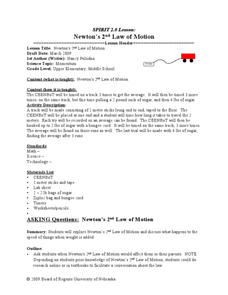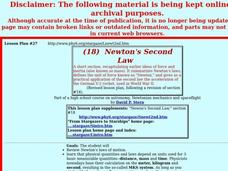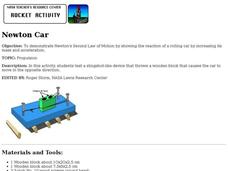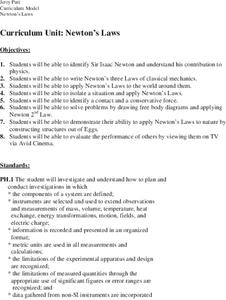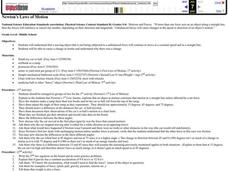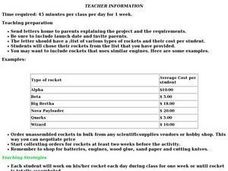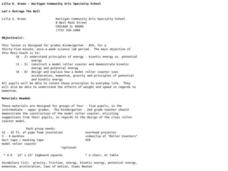Curated OER
Newton's Second Law
Three memorable activities build on each other to give physics masters a firm grasp of Newton's Second Law. Pupils play with a lab cart on a flat surface and on an incline to confirm that force is equal to mass times acceleration. In the...
Curated OER
Inertial Mass, Weight, and Newton's Second Law of Motion
The stage is set for you to guide future physicists through three forceful activities about motion. In the first, learners experiment with rolling carts to discover how objects interact. In the second, they inspect images of an object in...
Curated OER
Investigating Newton's Second Law Of Motion
Students participate in a lesson that investigates Newton's Second Law of Motion. They conduct an experiment of observing balls that are rolled down a ramp. The lesson includes background information for the teacher for preparation and...
Curated OER
Newton's 2nd Law
Fourth graders explore Newton's second law of motion, testing and identifying the characteristics of objects that makes them easier or harder to push. They identify what types of objects are the hardest to move, then test a variety of...
Curated OER
Newton's Laws
Young scholars identify Sir Isaac Newton and his contribution to physics. They write Newton's three Laws of classical mechanics. and apply Newton's Laws to the world around them. They isolate a situation and apply Newton's Laws.
Curated OER
Newton's 2nd Law of Motion
Students investigate how mass affects the speed of an object. In this physics lesson, students record data on the data table and graph results. They analyze findings and formulate a conclusion.
Curated OER
Newton's Laws and Rocketball
Students investigate Newton's Three Laws. For this Newton's Law lesson, students write the laws in their own words. Students then do an experiment with a ping pong ball. Students drop the ball from a set distance and record their...
Curated OER
Newton's Second Law
Students examine how physical quantities and laws depend distance, mass and time. They examine the MKS system; meter, kilogram and second, for doing calculations.
Curated OER
Rocket Activity
Students explore Newton's Second Law of Motion. In this rocket activity lesson, students experiment with Newton's Second Law of Motion as they use a slingshot device to force a car to move.
Curated OER
F = ma, Inertia, and Action-Reaction
Fourth graders apply concepts of Newton's Laws in scientific inquiries. Use this instructional activity to have your charges test and identify the characteristics of objects that make them easier or harder to push. After a teacher-led...
Curated OER
Newton's Earthquake
Students discuss Newton's 2nd and 3rd laws using the example of a football linebacker and a small child pushing against each other on an ice rink. Students are able to visualize the results of the push and link it to the laws. Discussion...
Curated OER
Newton's Laws
Students examine and discuss Newton's Laws and discover his contribution to physics. In groups, they participate in an experiment in which they much apply the Laws to the world around them. They describe contact and conservative forces...
Curated OER
The Physics of Skateboarding
Students explore Newton's three laws, gravity, momentum, trajectory, projectiles, circular motion, and friction by observing and breaking down skateboard tricks. They view short video clips of Tony Hawk and explain the physics concepts...
Curated OER
Pop Rocket - Trash to Treasure
First off, Newton's laws of motion aren't often taught at 2nd grade, so this lesson may be more appropriate for upper elementary learners. It begins with a discussion and demonstration of the laws of motion, and then has individuals...
Curated OER
The Inertial Balance
Students weigh objects using a triple beam balance. In this mass lesson, students use an inertial balance made with a metal rod to measure and graph vibrations of varying numbers of pennies in a bucket. References and discussion prompts...
Curated OER
Newton’s Laws of Motion
Eighth graders explore the three laws of motion. For this physics lesson, 8th graders observe teacher demonstration and explain what happened in terms of Newton's Laws. They complete worksheet at the end of the lesson.
Curated OER
Newton's Laws of Motion
Students perform three activities that each demonstrate one of Newton's Laws of Motion. They use a ramp and toy car to demonstrate inertia, calculate acceleration due to gravity, then use a medicine ball and rolling chair to demonstrate...
Curated OER
Waterskiing in Circles
Pupils discuss and give examples of Newton's three laws. They then answer questions in reference to Newton's three laws. One example of the questions that students answer is: A water-skier typically uses a 75 foot tow rope. The skier has...
Curated OER
Building and Launching Rocket Kits
Students, in groups, build and decorate rocket kits and then launch them.
Curated OER
Let's Outrage the Bull
Students study kinetic and potential energy. In this energy instructional activity, students in grades K-2 understand the differences between kinetic and potential energy. Students in grades 3-5 demonstrate that kinetic and potential...
Science Education Resource Center at Carleton College
Serc: Newton's 2nd Law: Inquiry Approach
In this activity, students test Isaac Newton's ideas on the nature of motion, in particular his 2nd Law. The emphasis is on the process of science, investigation, and experimentation, not the results. Students must come up with their own...







